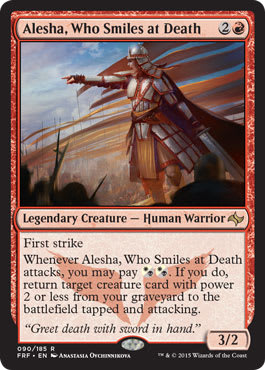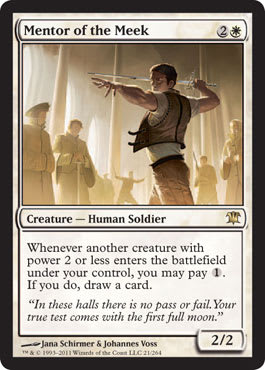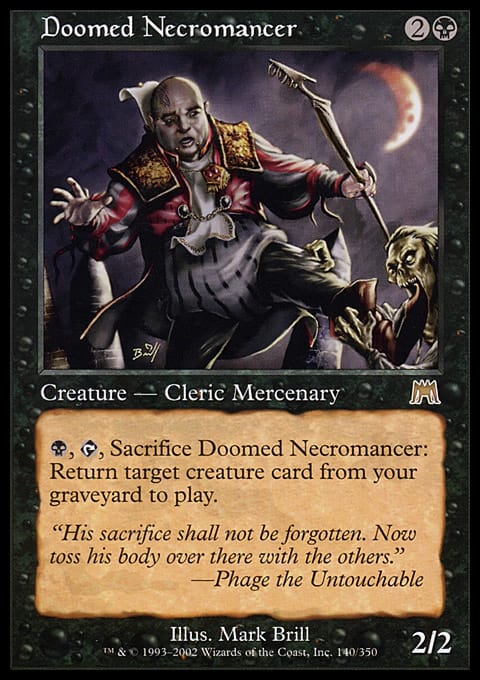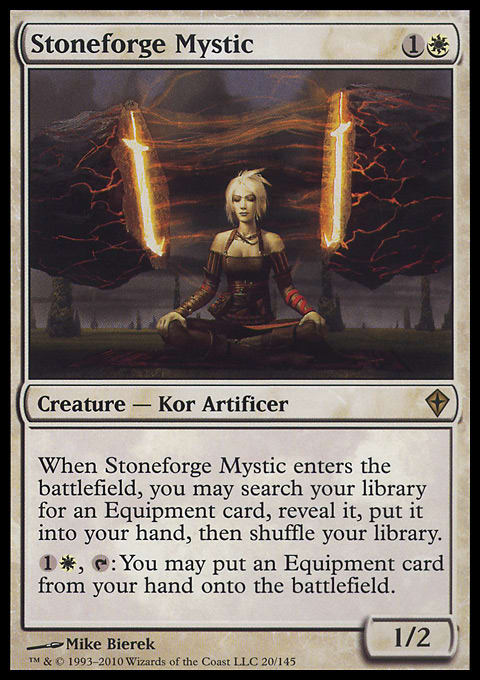I have to be honest for a moment. When I first saw Alesha, Who Smiles at Death, I was not impressed. She seemed like a card that was designed for returning aggressive creatures—for keeping the pressure up through sweepers and forcing spot removal. She did not seem to be a card that was designed for me. I could not have been more wrong.
Twitter has been rumbling about interesting Alesha interactions for a while now: Stoneforge Mystic, Imperial Recruiter, Solemn Simulacrum, Kiki-Jiki, Mirror Breaker. There are endless possibilities for generating value. What I didn’t realize at first glance is that Alesha is not really an aggressive creature. In actuality, she’s just a cheaper Sun Titan, and I love a Sun Titan more than most.
Since that realization, I’ve been brainstorming on and off about what the grindiest, most attrition-based Alesha lists might look like. How do you use Alesha to recycle resources besides creatures? How can her ability best lead to resilient board states that generate inevitability? These are the kinds of questions that I was looking for answers for. So how many ways are there to do absolutely nothing in Mardu? Despite these being traditionally aggressive colors, the answer may surprise you.
I’m a G/U player at heart, and because of that, all of my Commander decks start with the same question: How can I generate as much mana as possible? This is a format in which being able to consistently do multiple things or bigger things is rewarded, and that is contingent on having a powerful and consistent mana base. For this deck, that begins with Solemn Simulacrum, Kor Cartographer, and Burnished Hart. This deck wants to find one of these effects early on and use it to grind up to enough mana that you can start casting big spells and activating Alesha to start burying your opponents in value.
To that end, Corpse Connoisseur, Entomb, and Buried Alive function as additional copies of this type of effect. Imperial Recruiter works as well if you’re feeling particularly ambitious. The best part is that these don’t just provide early-game consistency, but function as powerful tutors throughout the game. Other options include effects such as Gamble or even transmute spells like Dimir Machinations and Dimir House Guard.
Once I’ve established an engine that ramps my mana, my next concern is finding one that draws extra cards. After all, ramping isn’t very good if you aren’t naturally hitting your land drops and don’t have enough action to invest spend your mana on. If I’m honest, this is among the most exciting parts of this deck to me because of how perfectly these cards fit in to the rest of the deck. After all, Disciple of Bolas and Mentor of the Meek fit right in when I’m trying to recycle 2-power creatures with enters-the-battlefield effects. Grim Haruspex and Harvester of Souls are less synergistic since they don’t have 2 power, but they are certainly powerful enough to make up for it.
If there’s one thing I’ve learned from my handful of Commander games with Alex Ullman, it’s this: Card advantage plus resilient board positions plus life total attrition is a pretty difficult combination to beat. Recursive attackers that generate cards when they bounce back and forth between the graveyard and the battlefield are bad enough, but when you start adding Blood Artist, Falkenrath Noble, and Rage Thrower effects, games get out of hand pretty quickly. The problem is that I’m not sure that plan is big enough. No matter how many times Alex proves otherwise with the likes of Teysa, Lyzolda, and more, it seems unlikely to me that you can win a game of Commander with anemic 2/2 attackers, no matter what they’re backed up with.
Enter the monster plan. I know I want this deck to go bigger. How else am I going to get my fill of maximum value Sun Titan plus Alesha attrition? The trick is finding a way to keep the giant monsters on the table and integrate them with the rest of your plan. For the longest time, this was the piece of the deck that I was missing, but when inspiration hit, it hit hard.
These pieces do all kinds of cool things, the most important of which is allowing Alesha to indirectly rebuy giant monsters such as Sun Titan and Harvester of Souls. Realistically, though, this gives the deck all kinds of exciting new angles. Not only can you rebuy big creatures, but you can do it at instant speed, especially if you have easy ways to give your creatures haste. Now we can play the likes of Butcher of Malakir and Aurelia, the Warleader without any fear, and we can even do fun tricks with combinations of Requiem Angel and Teysa, Orzhov Scion. Recursive Reveillarks make your board even more difficult to break up, and Flayer of the Hatebound becomes capable of generating enormous amounts of damage. Then you get to untap and do it all again.
One of the biggest workhorses in this deck is Stoneforge Mystic. Once you’ve assembled a reasonable amount of mana, a big part of the game plan is going to be cycling through Stoneforge Mystic to fetch a few key pieces of Equipment for different phases of the game. In the early game, it’s likely that you want some combination of Mortarpod, Swiftfoot Boots, and Lightning Greaves. After all, hasty creatures are a big deal, and you need a sacrifice outlet for your Solemn Simulacrum and Stoneforge Mystic. Eventually, though, you’re going to want to go bigger with the likes of Obsidian Battle-Axe, Sword of Light and Shadow, and even Nim Deathmantle, which is especially good with hasty Doomed Necromancers. These Equipment are important enough that it’s probably worth playing Godo, Bandit Warlord as another tutor, as well as a way of making extra combat steps.
The last key piece to this deck is appropriate sacrifice outlets. You want to make sure that you can consistently recycle your cheap value creatures and protect your bigger guys from removal like Swords to Plowshares, and efficient sacrifice outlets are the best way to do that. The easiest includes are both High Market and Phyrexian Tower, as they don’t cost anything to slot into your deck. From there, it becomes a little trickier. Viscera Seer slots in as a free outlet that Alesha can rebuy, while Goblin Bombardment contributes to your plan of whittling down life totals with Falkenrath Noble. Barrage of Expendables is much worse than either of these options, but I think it’s worth trying to see how big of a deal that extra mana actually is.
With all that in mind, here’s where my initial list has ended up:
Alesha Undying ? Commander | Carlos Gutierrez
- Commander (0)
- Creatures (40)
- 1 Viscera Seer
- 1 Skirsdag High Priest
- 1 Stoneforge Mystic
- 1 Apprentice Necromancer
- 1 Blood Artist
- 1 Doomed Necromancer
- 1 Duergar Hedge-Mage
- 1 Mentor of the Meek
- 1 Grim Haruspex
- 1 Burnished Hart
- 1 Imperial Recruiter
- 1 Athreos, God of Passage
- 1 Teysa, Orzhov Scion
- 1 Bone Dancer
- 1 Grenzo, Dungeon Warden
- 1 Hellrider
- 1 Falkenrath Noble
- 1 Throat Slitter
- 1 Disciple of Bolas
- 1 Kor Cartographer
- 1 Solemn Simulacrum
- 1 Crypt Champion
- 1 Brutal Hordechief
- 1 Siege-Gang Commander
- 1 Blinding Angel
- 1 Archangel of Thune
- 1 Kiki-Jiki, Mirror Breaker
- 1 Reveillark
- 1 Karmic Guide
- 1 Corpse Connoisseur
- 1 Flayer of the Hatebound
- 1 Harvester of Souls
- 1 Sun Titan
- 1 Aurelia, the Warleader
- 1 Godo, Bandit Warlord
- 1 Requiem Angel
- 1 Soul of Theros
- 1 Inferno Titan
- 1 Pentavus
- 1 Butcher of Malakir
- Spells (3)
- 1 Faith's Reward
- 1 Entomb
- 1 Buried Alive
- Artifacts (9)
- 1 Nim Deathmantle
- 1 Skullclamp
- 1 Mortarpod
- 1 Lightning Greaves
- 1 Swiftfoot Boots
- 1 Runed Stalactite
- 1 Obsidian Battle-Axe
- 1 Expedition Map
- 1 Nihil Spellbomb
- Enchantments (3)
- 1 Barrage of Expendables
- 1 Goblin Bombardment
- 1 Spirit Bonds
- Lands (44)
- 1 Ghost Quarter
- 1 Vault of the Archangel
- 1 Blood Crypt
- 1 Godless Shrine
- 1 Sacred Foundry
- 1 Clifftop Retreat
- 1 Isolated Chapel
- 1 Dragonskull Summit
- 1 Temple of Triumph
- 1 Temple of Silence
- 1 Temple of Malice
- 1 High Market
- 1 Phyrexian Tower
- 1 Arid Mesa
- 1 Marsh Flats
- 1 Bloodstained Mire
- 1 Crypt of Agadeem
- 1 Nomad Outpost
- 1 Command Tower
- 1 Emeria, the Sky Ruin
- 1 Vesuva
- 1 Shizo, Death's Storehouse
- 1 Urborg, Tomb of Yawgmoth
- 1 Mistveil Plains
- 1 Myriad Landscape
- 1 Bojuka Bog
- 1 Battlefield Forge
- 1 Caves of Koilos
- 1 Sulfurous Springs
- 1 Reflecting Pool
- 6 Plains
- 5 Swamp
- 3 Mountain
There are a couple of interesting interactions in this deck that I’m really excited to play with and a few that I just don’t know are good enough. I’m very excited to combine Mistveil Plains and Grenzo, Dungeon Warden to recycle creatures of all sizes at instant speed. I also can’t wait to suit up Alesha with a Runed Stalactite to gain extra combat steps off Godo, Bandit Warlord and Aurelia, the Warleader in the same turn, preferably with a Brutal Hordechief involved. I even am able to return to my roots and lock people out of combat steps with Blinding Angel!
The one thing that I’m most interested to figure out is which mechanisms of going big are most effective. Soul of Theros is a more consistent way to try to end the game, but Archangel of Thune is more efficient if it’s going to work. I just don’t know if it’s reasonable to generate enough Blood Artist triggers to make the team lethal before combat.
It’s distinctly possible that milling effects such as Undercity Informer are better in this deck than either Viscera Seer or Barrage of Expendables—perhaps even in addition to those cards. The ability to mill yourself toward giant monsters is certainly powerful, but once again, I’m not sure how important that 1 mana is.
Last, I want to talk about an interesting deck-building constraint that Alesha creates that I haven’t run into in a long time: accidental infinites. There are a lot of cards that do really cool things in this deck that I’ve chosen not to run because they create infinite combos that I’m personally not interested in playing with. Fiend Hunter and Banisher Priest, for example, are great ways to clear creatures out of the way and reset enters-the-battlefield abilities. Fiend Hunter even becomes permanent removal if you have a sacrifice outlet. Unfortunately, they both go infinite by flickering Sun Titan with a free sacrifice outlet in play. Similarly, Workhorse is a cool ritual with Alesha, but it goes infinite with Nim Deathmantle. Sword of Feast and Famine and Hellkite Charger are both interesting in this deck, but they can go infinite together. Even Goblin Matron and Wall of Blood are absurd in combination with Alesha. Goblin Matron can very easily set up the Kiki-Jiki-plus–Lightning Crafter combo, and it can even find Skirk Prospector as a sacrifice outlet if you need it.
There’s a thin line between these potentially game-breaking combos and what are just powerful interactions. For example, Alesha can bring the Wall of Blood into play attacking and trigger Flayer of the Hatebound. At that point, if you’re willing to dump enough life into it, you can easily kill two players. You can combine Treasonous Ogre and Children of Korlis to start generating obscene quantities of mana. You can use Mirror Entity plus Ashen-Skin Zubera to sacrifice your board and Mindslicer your opponent.
For all that work, though, you are rewarded with a deck that does a ton of interesting things and has a lot of cute interactions that add up to interactive and dynamic games. I can’t wait to sleeve this up and start fine-tuning my take on Alesha and her undying Mardu horde.





























